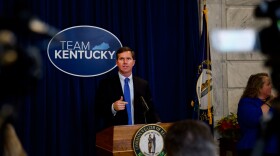Earlier this month, the National Endowment for the Arts doled out nearly $30 million in CARES Act funding to state, regional and territory arts agencies, with $454,100 going to the Kentucky Arts Council and $473,900 to the Indiana Arts Commission.
The NEA asked arts agencies to determine their own process for distributing these funds to arts and culture organizations in their communities.
Kentucky
In Kentucky, 93 arts nonprofits will receive emergency funds.
These organizations received operational support grants from the state arts council’s Kentucky Arts Partnership, in fiscal year 2020, which means they have already gone through the agency’s rigorous vetting process.
Chris Cathers, executive director of the Kentucky Arts Council, said the NEA gave “directives to each of the state agencies to get these funds out as quickly as possible,” and, by distributing funds to groups that had recently been reviewed, this allowed the council to do just that.
The regular grant program has six different tiers of organizations, based on operating revenues from “those who have $5 million or more in operations all the way down to under 100,000," Cathers said. Organizations will receive a flat amount based on their tier. Cathers said no group will receive less than $1,000 in these CARES Act funds and the highest grant will likely be a little more than $19,000.
The list of grantees includes more than 20 cultural institutions in the Louisville area, such as the Louisville Orchestra, Kentucky Shakespeare and the Speed Art Museum.
The funds must be spent toward operational expenses, like rent, utilities, payroll and artist/worker fees.
Cathers is also anticipating some additional money from the regional South Arts, which received $784,200 from the NEA’s CARES Act funding.
As for the state’s arts organizations that aren't included in that 93, Cathers said the council is in contact with a number of groups and has offered assistance in the form of consultation and guidance toward other resources available to those impacted by the COVID-19 pandemic.
Indiana
The Indiana Arts Commission put a portion of its CARES Act funding shares from both the NEA and the regional Arts Midwest toward its Indiana Arts Emergency Relief Fund program, which it established in response to the pandemic.
Director of marketing and communications, Bridget Eckert, said the fund has $582,900, with some support coming from the commission itself.
About 200 arts groups across Indiana are eligible for a $2,500 to $3,000 grant through this emergency relief program — all of these organizations have received operational support from IAC in the current year, according to IAC executive director Lewis Ricci.
“All of our grantees typically are vetted...by independent panels that make recommendations to the full commission for funding,” Ricci said. “That's a lengthy process. We've set it up so that all of our current operational grantees can have a piece of these funds.”
Ricci said, similar to the Kentucky Arts Council, distributing the money to these already-vetted groups allows them to get these emergency funds out faster. All the groups have to do is complete an online application.
The recipient organizations will have to provide documentation on how these funds will be used, “so to make sure it’s keeping within the CARES Act” parameters, he said.
“Then they're also asked to give us a short description of how they are operating during the time of COVID-19 right now...the ways in which they have adjusted, the way they deliver programs or services to stay connected to their communities and their constituents,” Ricci said. “And that is something we want to collect, we want to know basically how people are coping with the situation and remaining valuable assets to their communities.”
The Argument For The Arts
Some federal lawmakers criticized the decision to designate a portion of the $2 trillion dollar stimulus package to the arts and culture sectors, calling it “wasteful spending.”
Chris Cathers, of Kentucky Arts Council, pushes back against that, saying, “the arts are a positive investment.”
“The arts contribute to the economy,” he said. “The arts create jobs. These are individuals who are working, who are contributing just like everyone else, and it’s very important that we acknowledge that.”
Recent numbers from the United States Bureau of Economic Analysis show that the creative sector is a more than$877 billion a year industry. The Kentucky Arts Council reports that the state’screative workforce is around 108,498 people, representing 2.5% of Kentucky’s overall employment. And in Indiana, the creative economy provides about 160,000 jobs, more than 87,000 of which are people working at arts organizations, according to the state arts commission.
“The arts also strengthen our education and cultivate the imagination,” Cathers said.
The arts are “these great connectors,” Indiana Arts Commission’s Lewis Ricci said. They build community, which is why he thinks we’ll need the arts more than ever on the other side of the pandemic, “because of mental health issues and a lot of things that accompany being isolated and the normalcy of life not happening.”





